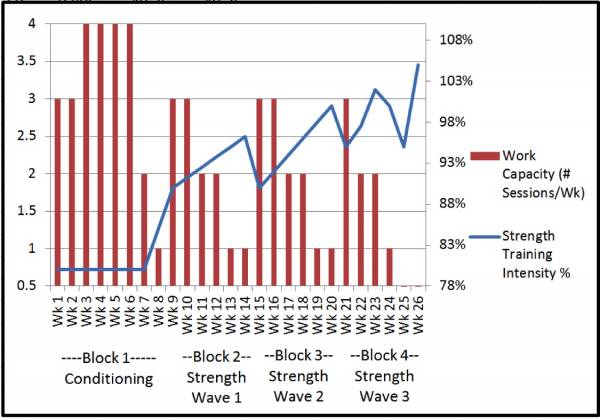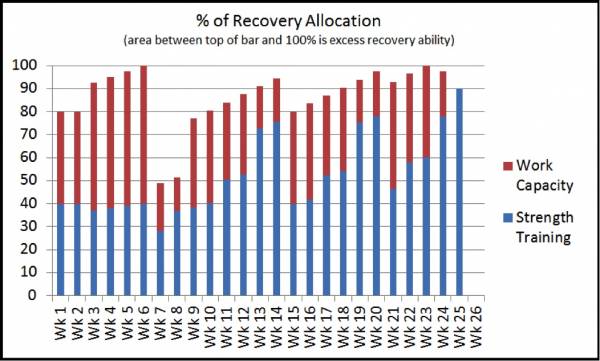An athlete recently asked me how to achieve peak conditioning and peak strength levels simultaneously. To his disappointment I noted this realistically could not be achieved. It’s not the case, however, that one entirely negates the other. In fact the correct interplay of both conditioning and strength can maximize your performance in either.
Maximizing performance in your desired objective (either strength or conditioning) doesn’t mean simply incorporating the opposite and hoping for the best. Imagine an endurance runner tossing in a bunch of strength training leading into a running event or a large out of shape powerlifter slamming out a bunch of cardio leading into a meet. In both scenarios the athlete will likely reduce their performance. CrossFit has done an excellent job at incorporating training across the strength and conditioning spectrum (or broad modal domains in CF language), but at the same time its athletes are not in “peak” shape for any specific points within those spectrums.
At this point it may sound like I’m all for very specific training for competitive athletes. This is not the case and in fact I firmly believe maximal performance on the platform (or whatever the performance venue) requires incorporation of both strength and conditioning. It becomes not a question of “should you” but “how.” If you’re focusing on strength athletes, as this article does, the key point is to setup your training so the conditioning is supporting you as reach your strength objectives. Often, conditioning is implemented as a secondary goal, but done so in a manner that detracts from the primary objectives, when it could be accelerating them.
Looking at pure strength sports, such as powerlifting or Olympic lifting, it can be argued conditioning has no direct application at the time of the event. With a mixed sport such as strongman it becomes a little less clear. In pure strength sports the competitive event involves strength, speed, and technique, with conditioning hardly impacting the outcome of the performance. If, however, we take a step back to the training leading to the event, we will see a different story. An athlete with improved conditioning will be able to train harder and longer and recover faster, allowing them to get more out of their training cycle leading to the event. If you take two athletes of the same strength levels (all other factors the same) the one who has better conditioning leading into the meet training cycle will simply perform better due to these factors.
Waves of Conditioning Micro-cycles
Conversely, an athlete pushing too hard on the conditioning side during their competitive training cycle will not have the energy reserves or recovery ability to maximize their strength training. Let’s take a look at it, as we did in the example above, but change it to two athletes of the same strength and conditioning levels leading into a competitive training cycle. The athlete who simply coasts and tries to maintain his conditioning levels with the focus being on his strength training will outperform the athlete who continues pushing both as hard as he can. The “coasting on” of conditioning levels can be taken even a step further – by constructing waves of conditioning micro-cycles you can realize strength bumps at key points in the training cycle and for the meet.
I’m sure I’ve bored you with the theoretical at this point. Let’s talk application. I’m going to provide you with some examples of how I arrange training cycle for a competitive strength event for myself and some of my athletes. The training plan example we are going to step into is not for a new athlete, but someone who has already developed a fair-to-significant level of strength and conditioning. The concepts can be used for other conditions, but for example purposes we are going to stick with one training plan.
With a 12-18 week meet training cycle in mind, I will back off 8 weeks prior to the start of that. During this 8 week block I keep the weights at a moderate level and focus primarily on bringing up conditioning levels. Often, the weight training sessions are set up as circuit training to maintain focus on conditioning as well. The first 6 weeks of this training block I will ramp up the conditioning and then taper it down the last two weeks. If someone is in moderate conditioning levels to begin with, a 6 week period of intense conditioning training is all that is needed.
After the pre-training conditioning block we move into the strength training cycle. With the taper at the end of the conditioning block we should be primed to start ramping up the strength training. I usually do 6 week training blocks. With each 6 week training block I overlay my conditioning (labeled Work Capacity in the chart) work. As I wave my strength-training block up, I wave my conditioning down. I repeat this 2-3 times, each time waving the strength training a little higher. In the final block I deload the strength training along with the conditioning deload leading into the meet. (See my article on 3, 2, 1, 0 Meet Preparation Countdown.)

In the example above I’m only showing two variables, but you can obviously use several methods to wave your strength and conditioning levels. For Work Capacity I just looked at the number of HIIT (high intensity interval training) GPP (General Physical Preparedness) sessions done per week for conditioning. This works well for me as I have a number of fixed sessions for team members, thus making it easy to manage. For strength training I just summarized with a fictional % intensity figure. This can be handled via periodization, block periodization, conjugate (my preference), or other training methods.
- Block 1 – Conditioning ramp up “pre” competitive cycle
- Block 2 – Strength training waved up, conditioning waved down
- Block 3 – Strength training waved up, conditioning waved down
- Block 4 – Strength training waved up ant then down, conditioning waved down
Another way to visualize this is by imagining the amount of resources you are dedicating to recover in each of these aspects each week. That allocation will be changed during each block, transitioning from Work Capacity to Strength, while the entire block is waved upwards in intensity. An example of what this would look like with the same training cycle is shown below.

Staging your conditioning training correctly will allow you to incorporate it in a manner supporting and accelerating your strength training, versus it detracting if done incorrectly. In addition, you will typically have the side benefits of being leaner, with better abs, and not having to pant when reach the top of a flight of stairs – which is always a plus.






